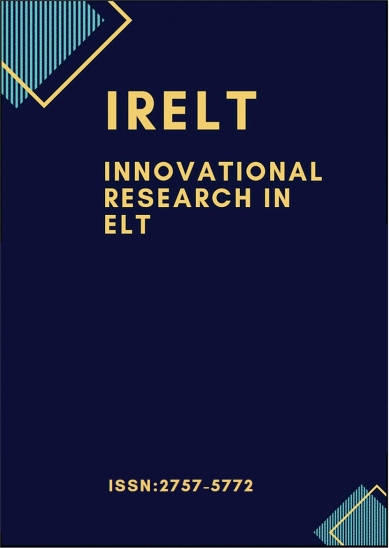Research article | Open Access
Innovational Research in ELT 2020, Vol. 1(1) 10-20
Using flipped classroom model for developing speaking skills: An integrative review research
pp. 10 - 20 | DOI: https://doi.org/10.29329/irelt.2020.311.2
Publish Date: December 17, 2020 | Single/Total View: 823/1.237 | Single/Total Download: 1.704/2.708
Abstract
This integrative review research's aim is to compare the eight studies that explore the effects of flipped classroom model on developing the speaking skills of the students. In order to analyze the data, this integrative research adapts an inductive content analysis approach because the data gathered from each of the articles are described through tables by grouping the data through themes and categories. Students' attitudes towards the flipped classroom model and positive and negative effects of the flipped classroom model and its strengths and weaknesses in terms of developing speaking skills are explored in this study because the research questions are centered on these issues. The results show that the flipped classroom model enhances the speaking skills of the students because it provides an environment for the students to become confident and autonomous in their own language learning and they are exposed to language both inside and outside of the classroom. However, flipped classroom's negative impacts are expressed in several studies. Some of the negative impacts are related to the long learning process and affective factors. Although there are both negative and positive effects of flipped classroom model on the development of speaking skills, nearly all of the studies indicate that it provides a meaningful, collaborative and active learning environment where students can engage with one another and speak English all the time by engaging in meaningful activities through collaboration.
Keywords: Flipped classroom model, speaking skills, collaborative learning, integrative review research.
APA 7th edition
Sonmez, N. (2020). Using flipped classroom model for developing speaking skills: An integrative review research. Innovational Research in ELT, 1(1), 10-20. https://doi.org/10.29329/irelt.2020.311.2
Harvard
Sonmez, N. (2020). Using flipped classroom model for developing speaking skills: An integrative review research. Innovational Research in ELT, 1(1), pp. 10-20.
Chicago 16th edition
Sonmez, Necati (2020). "Using flipped classroom model for developing speaking skills: An integrative review research". Innovational Research in ELT 1 (1):10-20. https://doi.org/10.29329/irelt.2020.311.2
Abdullah, M. Y., Hussin, S., &Ismail, K. (2019). Implementation of flipped classroom model and its effectiveness on English speaking performance. International Journal of Emerging Technologies in Learning, 14(9), 130-147.
Al-Ghamdi, M., &Al-Bargi, A. (2017). Exploring the application of flipped classrooms on EFL Saudi students’ speaking skills. International Journal of Linguistics, 9(4). 28-46.
Amiryousefi, M. (2017). The incorporation of flipped learning into conventional classes to enhance EFL learners’ L2 speaking, L2 listening, and engagement. Innovation in Language Learning and Teaching, 13(2), 147-161.
Baker, J. W. (2000). The ‘’classroom flip’’: Using web course management tools to become the guide by the side. In J. A. Chambers (Ed.), Selected papers from the 11th international conference on college teaching and learning (pp. 9-17). Jacksonville, FL: Florida Community College at Jacksonville.
Cooper, H. M. (1982). Scientific guidelines for conducting integrative research reviews. Review of Educational Research, 52(2). 291-302.
Elo, S., &Kyngas, H. (2008). The qualitative content analysis process. Journal of Advanced Nursing, 62(1), 107-115.
Kim, B. (2001). Social constructivism. In M. Orey (Eds.), Emerging perspectives on learning, teaching, and technology. Retrieved from http://projects.coe.uga.edu/epltt
Köroğlu, Z. Ç., &Çakır, A. (2017). Implementation of flipped instruction in language classrooms: An alternative way to develop speaking skills of pre-service English language teachers. International Journal of Education and Development using Information and Communication Technology, 13(2). 42-55.
Li, S., &Suwanthep, J. (2017). Integration of flipped classroom model for EFL speaking. International Journal of Learning and Teaching, 3(2), 118-123.
Lin, C.-J., & Hwang, G.-J. (2018). A learning analytics approach to investigating factors affecting EFL students’ oral performance in a flipped classroom. Educational Technology & Society, 21(2), 205-219.
Richardson, V. (1996). From behaviorism to constructivism in teacher education. Teacher Education and Special Education, 19(3), 263-271.
Russell, C. (2005). An overview of the integrative research review. Progress in Transplantation, 15(1). 8-13.
Tetreault, P. L. (2013). The flipped classroom: Cultivating student engagement.
Torraco, R. J. (2016). Writing integrative reviews of the literature: Methods and purposes. International Journal of Adult Vocational Education and Technology, 7(3). 62-70.
Tütüncü, N., &Aksu, M. (2018). A systematic review of flipped classroom studies in Turkish education. International Journal of Social Sciences and Education Research, 4(2), 207-229.
Whittemore, R., &Knafl, K. (2005). The integrative review: Updated methodology. Journal of Advanced Nursing, 52(5), 546-553.
Wu, W.-C. V., Chen Hsieh, J. S., &Yang, J. C. (2017). Creating and online learning community in a flipped classroom to enhance EFL learners’ oral proficiency. Educational Technology & Society, 20(2), 142-157.
Yeşilçınar, S. (2019). Using the flipped classroom to enhance adult EFL learners’ speaking skills. PASAA: Journal of Language Teaching and Learning in Thailand, 58, 206-234.
